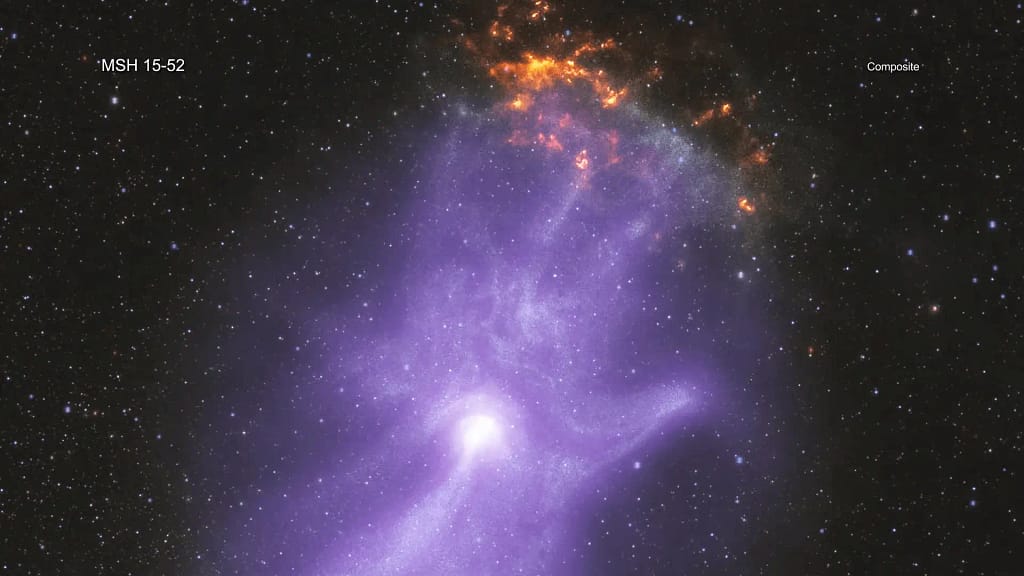In 1895, Wilhelm Röntgen made a groundbreaking discovery when he used X-rays to image the bones in his wife’s hand. Little did he know that this would mark the beginning of a revolution in diagnostic tools for medicine. Fast forward to the 21st century, and X-rays have transcended their initial medical applications. Today, Chandra X-ray Observatory has joined forces to reveal the magnetic field “bones” of a celestial hand-like structure in space, known as MSH 15-52. This extraordinary discovery sheds light on a fascinating story that began over 1,500 years ago, involving a giant star’s dramatic end, the formation of a neutron star, and the birth of a pulsar wind nebula.
In this article, we will delve into the captivating journey of X-ray astronomy, exploring how X-ray telescopes are transforming our understanding of cosmic phenomena.
The Birth of a Pulsar Wind Nebula
The story of MSH 15-52 begins with the demise of a massive star, which exhausted its nuclear fuel and subsequently collapsed in on itself. This catastrophic event gave rise to a neutron star, a dense celestial object with intense magnetic fields, often referred to as a pulsar. These pulsars are known for their rapid rotation and strong magnetic forces, making them ideal subjects for studying extreme physics under high-energy conditions that cannot be replicated on Earth.
Pulsars serve as cosmic laboratories where astronomers can observe phenomena that defy terrestrial conditions. One such phenomenon is the creation of jets of matter and antimatter that emanate from the pulsar’s poles, accompanied by an intense wind. This combination of elements forms a structure known as a “pulsar wind nebula.” These nebulae offer unique opportunities to explore fundamental questions in the field of physics, and it is through the lens of X-ray telescopes that we gain insights into their intriguing characteristics.
Chandra X-ray Observatory
In 2001, NASA’s Chandra X-ray Observatory observed the pulsar PSR B1509-58, which is the pulsar at the heart of MSH 15-52. This observation revealed a remarkable discovery: the pulsar wind nebula MSH 15-52 bore a striking resemblance to a human hand, with the pulsar itself located at the “base of the palm.” The hand-like structure captured the imagination of astronomers and the public alike.
In December 2021, NASA’s Imaging X-ray Polarimetry Explorer (IXPE) embarked on its mission to observe celestial objects in X-rays. Among its targets, MSH 15-52 received special attention. The IXPE’s prolonged observation of MSH 15-52 for approximately 17 days marked the longest continuous study of a single celestial object since the telescope’s launch.
The data collected by the IXPE have provided astronomers with the first comprehensive map of the magnetic field within the hand-like nebula. This magnetic field plays a fundamental role in shaping the nebula and guiding the paths of charged particles responsible for generating X-rays. The magnetic field’s influence is akin to how the bones in a human hand define its structure. Consequently, magnetic field mapping has offered a deeper understanding of the intricate details of MSH 15-52, uncovering facets of this cosmic hand that were previously concealed.
The collaboration between NASA’s Chandra X-ray Observatory and the Imaging X-ray Polarimetry Explorer is not only about MSH 15-52. The data from these two telescopes are facilitating a broader exploration of pulsar wind nebulae and their enigmatic features. Researchers are eager to unearth more discoveries in this fascinating field, and the data collected thus far promises to be a treasure trove of information.
The combined efforts of NASA’s X-ray telescopes have unveiled the magnetic field “bones” of MSH 15-52, a pulsar wind nebula that resembles a cosmic hand. This extraordinary discovery represents a significant milestone in X-ray astronomy, shedding light on the unique characteristics of pulsar wind nebulae and the role of magnetic fields in shaping celestial structures. As the exploration of MSH 15-52 continues and more data are analyzed, we can expect further revelations about this captivating cosmic phenomenon. The story of X-ray telescopes and their role in understanding the universe is an ever-evolving narrative that continues to capture the imagination of scientists and the public alike, opening new windows into the mysteries of the cosmos.




